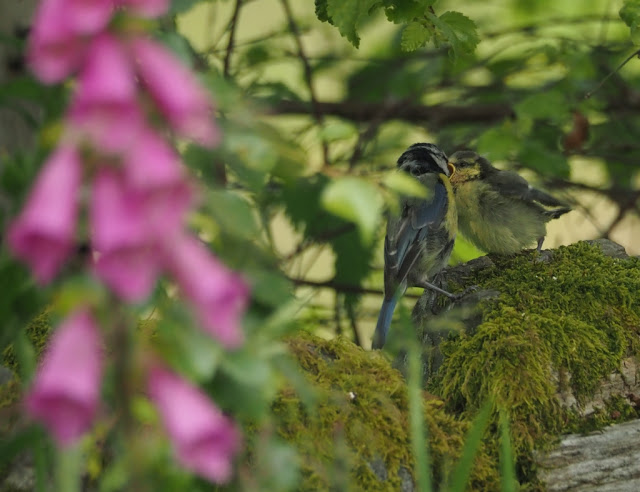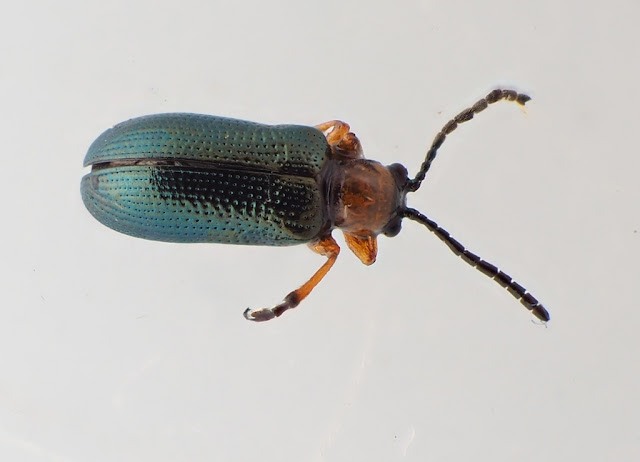Being a bit of a pedant about documenting records keeping up with iRecord, in particular, is hard work. I'm quite behind.
However, I have managed to finish my review of the Orkney micro-moths, hopefully that will be of use. There are still quite a few loose Orkney ends to tidy up.
Anyway, here in Perthshire I'm a bit challenged with identification problems, and I've hardly run light traps as it's been quite cold.
 |
| Tenthredopsis nassata, female. |
This rather lovely sawfly was in the roadside verge not far from the house. Obsidentify suggested Tenthredopsis scutellaris. On checking NBN that's quite a rare species, a little research revealed that T. nassata was more likely, particularly as this was quite a large animal, probably at least 12mm long. Trying to key this from a photo is nigh impossible, however, T. coquebertii can be ruled out on the colouration of the head and size ruled out scutellaris. I should really have taken the specimen.
This fungi is quite common round and about.
 |
| Puccinia urticata. |
It seems straightforward until you investigate a little further and discover that there are umpteen micro-species. My feeling is that life is too short to try to take this further, whether or not I should PSL tick this is another matter (it is ticked at the moment).
Nearly every day I have a good wander around The Ross patch. Until yesterday Redstart had proved quite elusive, being heard twice on the patch. The hound and I wandered up the estate road, Reed Bunting was singing, and there on the fence behind it, where I'd not heard Redstart previously, was a Redstart.
 |
| Redstart in Oak Tree. |
Nice views and rubbish photos were obtained. And it was only the second time I'd located Reed Bunting. I wandered a couple of hundred metres up the track, and there was another Redstart. This one was in and out of the trees and on the boulders beside the roadway. My only explanation for this is that eggs have hatched and young are now needing to be fed so the males are more active feeding, and thus more visible.
Also this week excellent views of Garden Warbler, a Goosander with seven chicks, Grey Wagtail with young, but I think nothing new.
Blue Tits were feeding young in the garden.
 |
| Blue Tits. |
There are at least two pairs of Common Sandpipers, one pair on each river.
 |
| Common Sandpiper. |
On the mammal front Daubenton's Bats are very active by The Ross bridge with Soprano Pipistrelles nearby along the back road. A fawn showed with a Roe doe on the estate.
 |
| Roe fawn. |
The one light trap session produced a nice Brussels Lace, and the only other moth of interest escaped before I pressed the shutter button.
 |
| Brussels Lace. |
I finally got around to identifying the tiny beetle that I'd found on the kitchen window ledge, it turned out to be Anthrenus fuscus. An interesting species, only found in Scotland in 1993. Before I vacced in the kitchen I took the pooter and had a bit of a more careful look along the window ledge. Nine more A. fuscus, some Dolychopidae, which I've yet to attempt, a Sylvicola cinctus, which I had to dissect, and an interesting, brightly covered Chrysomelid cereal beetle. Unfortunately there are two species that are pretty much identical externally, more dissection required.
 |
| Oulemma duftschmidi, male (fortunately). |
I followed the instructions for dissection on UK Beetles and eventually got the bits out clean. At this point it's not immediately obvious what to do next. Fortunately for me the flagellum, which can be hidden in amongst all the male bits, was partially extruded, and it matched the appropriate illustration. There are very few records of this beetle in Scotland, so a good result.
 | |||
| Anthremus fuscus, a small thing at 2.4mm but fortunately quite easy to identify, due to the antennae which are distinctive. |
I had another wee look at the Community Woodland. The raspberry bushes were heaving but it was the beetles which most entertained with Orchid Beetle and another member of a tricky species pair Oedemera lurida. Males of this pair are easy enough, but first figure out if the beetle you have is male or female.
 | |
| Oedemera lurida, a female. |
I took a specimen, but unfortunately the image didn't turn out as well as I hoped, although I think I can see an indent in the last sternite.
 |
| Female, Oedemera lurida, showing the indent in the last sternite. |
However, I found the species again later in the week, and a male was clearly interested in a female, width of femur 3 = femur 2, at any rate not significantly expanded, so this confirmed the id. Not that easy though.
I've very kindly been sent some statistical information about this species pair which is helpful for the separation of them in the field (thank you BP). Body/thorax/head length means for males and females:
Oedemera virescens: males 8.9mm and females 9.2mm Oedemera lirida: males 7.3mm and females 6.8mm
This data should be applied with caution as there is quite a bit of variation within each species, however, it is interesting that in O. virescens males average smaller than females whilst in O. lurida males average larger. In the pair I observed two days ago the male was clearly the larger animal. In the field this information may be handy. In O. virescens the male has the hind femurs swollen, they are clearly larger than the femurs of the mid legs. There's a useful French paper on the Oedemeridae here - https://tinyurl.com/53zk4fnz
 |
| Oedemera livida, male is on the left. |
 |
| Dascillus cervinus, Orchid Beetle. |
Also at the Community Woodland a couple of nice moths.
 |
| Chrysoteucha culmella. |
 |
| Micropterix calethella. |
A few things yet to do, some beetles from the river gravels,and a few puzzling Platycheirus hoverflies, as well as a tiny Empid. A few plants to follow up on as well, plants where I need to go back with book in hand to check the details. Hopefully the weather will perk up a bit....





No comments:
Post a Comment